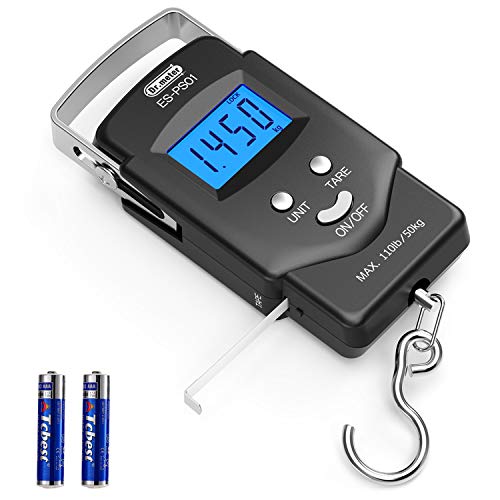I couldn’t believe my eyes as I looked at the 5 day weather forecast in late January. It claimed that not only would the following Saturday, Groundhog Day, be totally sunny, but that the temperature would blaze up into the low 50s! I know I never catch any fish in the winter, but this was an opportunity to get outside and look at some new water. After a few words with the Basswife, I convinced her that she really did need to visit her twin sister who lives just south of Baltimore and I was ready to go.
Despite some anxious moments over the next few days as I watched the forecast, we found ourselves on the road to Baltimore early Saturday drinking hot WaWa coffee and choking down a breakfast sandwich. I did a quick dump and run; pulled up to the driveway, she hopped out and I was headed to the Gunpowder before she got into the house. Why the Gun? Despite my unrelenting bad impression of the Prettyboy section which features a fisherman every 25 yards on the weekends, the Gun is a great river that stretches for miles. Besides, with the huge amount of rain that poured into Northern Virginia and Maryland on Friday, most of the other close-in rivers would be blown out. The Gun is controlled by the release from Prettyboy and that also limits the amount of sediment that enters the water.
Besides, I had done a recon of the Big Falls Road access point last year and had not been back to really check it out – so that was my destination. The first thing I noticed when I pulled up was the massive construction project underway. The bridge was out! The road guys were redoing the bridge and, from the looks of the deep gashes carved in the surrounding hills, they must be up to other mischief as well. Without gearing up, I hurried down to the river and was thankful to see that the water was flowing clear; no sediment to ruin this great winter day.
With the construction, access to the paths from the south is not obvious. I had to dodge around the construction fence and debris, working through some thick brush (glad I had my shears with me) to finally burst out on the small trail that runs up the southern bank of the river. I got a kick out of the fact that every puddle on the trail was iced over and that I was the guy breaking that ice; proving I was the first to arrive. Now, the standard dilemma. Walk or fish?
Usually, I walk in at least 0.5 miles before fishing, but I was a little pressed for time. It was 1030 and I had to leave no later than 1400. I compromised and walked a few hundred yards upstream of the bridge and then slid down the icy bank to hit the cold, cold, cold water. For Christmas, the Basswife gave me a cool laser thermometer that quickly confirmed the surface temperature was a chilly 37 degrees. Hmmm. According to what I have read, trout basically go dormant when the water is below 45 and do not actively feed. This did not bode well for a day of “catching”, but I was here to go “fishing” anyway.
The Gunpowder is a schizophrenic river. After boiling out of the picture perfect Prettyboy section that features an absolute overload of trouty water with stark rocks, deep pools and tight overhead vegetation, it flattens out into the typical Maryland stream. That transition occurs up at Masemore and Big Falls is much farther south. The most noticeable feature of the Big Falls section is the steeply slanted banks; the river is like a gash. You have to exercise care in picking your spot to enter or leave the river. If you are willing to slide/fall into the water, pretty much anyplace offers access while finding a gentle slope to ease in could take a while. I chose the slide/fall approach and deftly exercised old parachute landing skills from the Army as I plummeted into the stream and immediately sunk in up to my knees.
Ha! Another element of the schizo. The bottom is either slit or gravel. As I learned later in the day, you can trust the gravel for firm footing, but be careful of anything that looks like slit. It can either be a slick, shallow coating over hard ground or it can be quicksand. This really is an issue if you need to trust your footing as you try to dance between footholds approaching pools. Time after time, I put my foot down between branches as I worked around structure only to sink to mid-shin or knee. After almost pitching into the river twice, I learned not to rely on that footing; careful, testing steps were in order.
One interesting aspect of winter fishing is that you see the bones of the river. Everything is dead. No green, no grass, just the skeleton of the terrain; exposed in the sun. I felt like I was a homebuyer who wandered into a poorly decorated house, telling myself that it was the “bones” of the home that mattered. After letting my eye roam in the many rooms of this river, I have to give it a thumbs up. Pull out the contract and sign on the dotted line!
The river ranges in width between a tight 10 – 15 feet up to 30 in this stretch. When you approach the river, the potential of all of the structure is obvious. Talk about fish magnets! There are deep pools next to undercut banks. There are numerous down trees stretched across the river just waiting to snag your fly on a reaching cast just a few inches too long. There are narrow, fast sections that have perfect feeding seams on both sides. There are also dead zones. I keep giving advice I don’t take myself. On this water, you need to walk the bank. Go past the area you want to fish to validate that it is deep enough to hold trout and then return to exploit that knowledge.
For all the feeling of being remote, this is not remote water. It is, after all, within a short drive of Baltimore and is even within a radius considered close by folks like myself from Northern Virginia. So, there is pressure. Even on this cold Groundhog’s Day, I saw 6 other guys.
About an hour after I arrived, I looked downstream and saw another guy working upstream. Wanting to chat and get some advice since he was clearly better at this fly stuff than I, took a break and stopped at a nice section. Settling in on a sun baked log, I pulled out my thermos and enjoyed a hot cup while I waited for him to appear around the bend.

I have yet to run into an unfriendly fisherman and he was no exception. He was using beadheads, no luck. That mirrored my experience. I was floating a wiggle pattern stonefly with a dropper as well as using streamers like the Patuxent Special to no avail. I told him I had not fished the nice spot in front of us and that I would go another 200 yards upstream to give him some room.
He leapfrogged me later in the day as I worked a great pool braced by a huge stack of dead trees. That was the last I saw of him but I encountered two other groups who were just starting in as I was leaving. One guy, dressed in stealth green, confirmed the “no luck” assessment and was using stones. The other group was just upstream of the bridge and were in the early stages of both looking at the water and looking for bugs. Sadly, I could not give them any advice beyond what did not work for me.
On my earlier recon, I noted that there were a number of other cars parked at the trailhead. Experience on this day confirmed that observation. Measured by parked cars, this is a popular stretch. But, the length of the section mitigates the pressure. If you walk in a mile and then start fishing, you will not have a problem. Also, I did see 3 groups of hikers on the path, so some of the cars scattered along the side of the road will belong to members of polite society who are not terminally addicted to this sport we call fishing.
A common description of the entire upstream section would be that it has deep wide pools punctuated by trees and bushes, with a few scattered rocks poking up to provide some character. About 20% of Big Falls is a flat run over slit or gravel that, on this day, was only inches deep. You could waste a lot of fishing time working up the river. Instead (and I promise to start doing this myself), walk past, check it out and then walk back to hit the water.
I was impressed with the park-like nature of the terrain surrounding the water. In the dead of winter, there was no underbrush clogging the banks. There are extended sections of tall, thick trees that are not choked in underbrush. Instead, it’s as if somebody mowed and groomed these areas. It was really noticeable where I turned around. The southern bank looked like a National Park Campground – cleared and ready for excited campers to disgorge from RVs. While you cannot drive anything back here, I should note that the trail on the northern bank is almost a road. It is wide, flat and easy to walk. It does not go close enough to the river to see the water in most places, but it is a high speed avenue of approach that you can use to strike deep into this section.
However, given the steep banks, you need to be in moderate, non-sedentary shape to fish here. You will have to climb in and out of the water. Other than that, anyone could fish here without a problem.
Gunpowder River Trout Fishing Bottom Line: Nice, good water. I liked this section of the Gun. It’s catch and release, so the regulations are good as well. At 37 degrees, my lack of luck should not be held against it.
On this day, you could see that the water level was low by looking at the high water pattern on the banks. The normal flow produced a nice cut in shelf in most places; creating a great holding area for trout. When I return this summer, I look forward to floating a terrestrial pattern to tempt the trout lurking under this protective cover.
The distance from the current water level to the bottom of the shelf was about 2 feet in places. Hopefully, the Dam will increase the flow to fill this up as we sweep into the spring season.
Getting There: Head north on 83 and get off at exit 27 for Mt Carmel. Head East until the road dead ends. Turn right (York Road) and then take an immediate left onto Monkton Road. Follow this for a bit and take the left onto Big Falls Road and follow it to the Gunpowder. There are several different pulloffs around the bridge.
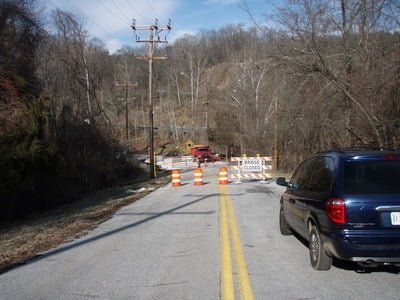
Current state of the parking area – you can get to the river on the left
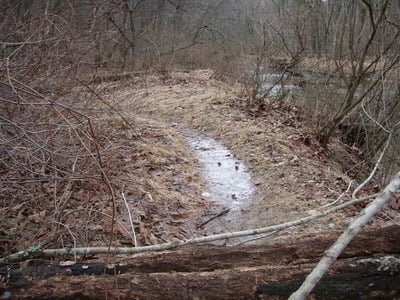
Ice! This is the trail on the southern bank
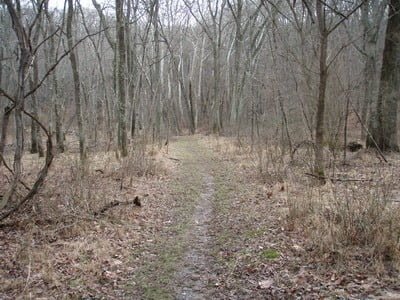
The trail on the northern bank – much better
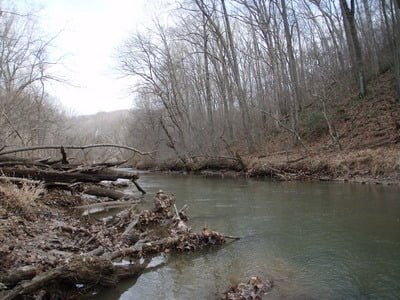
Structure and deep water
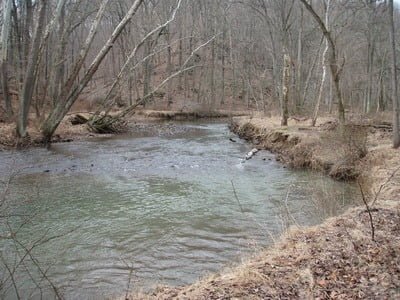
In the spring, when these trees have leaves, this will be picture perfect
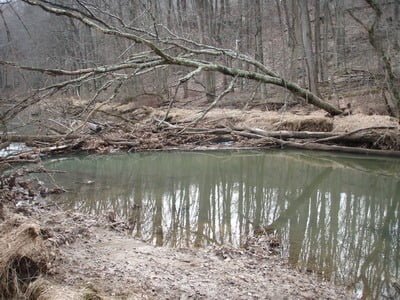
This is the “beaver” pool I worked. It is deep here and the overhanging tree taunts you into doing suicide casts to try and lay the fly right next to the dam
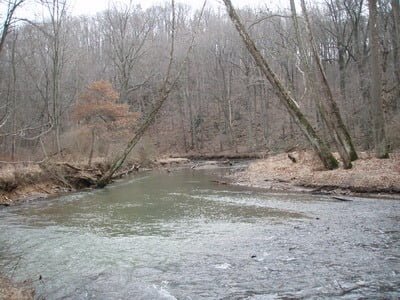
Looking downstream, it’s easier to see the shallow stretches. I wasted time working up this section – it was only a few inches deep.
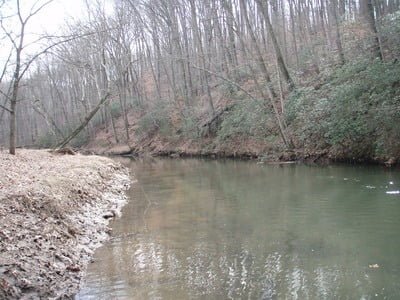
Look at that bank on the right! Bushes, overhang. This will hold fish when it is warmer
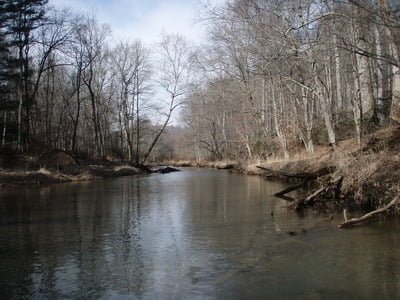
Deep section up near where I turned around. These deeper areas always have a sunken tree or two in the middle
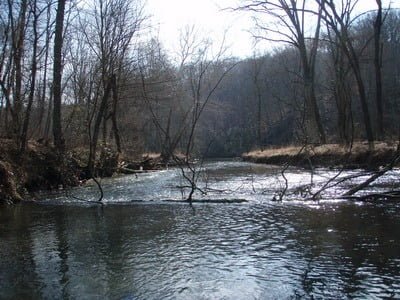
The weak February sun poked out later in the day making for a great fishing experience
Unless stated otherwise, this article was authored by Steve Moore

